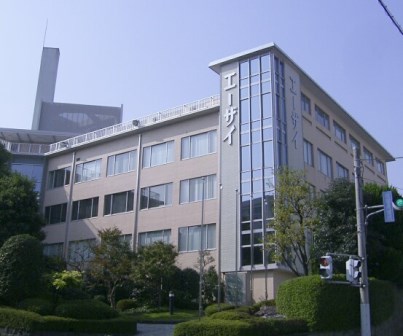Eisai and Purdue Pharma announced six-month results from SUNRISE 2, a long-term Phase 3 clinical study evaluating the efficacy and safety of lemborexant, an investigational agent being developed for the treatment of insomnia, a sleep-wake disorder.

Image: Eisai head office in Tokyo. Photo: courtesy of KW / Japanese Wikipedia.
Subscribe to our email newsletter
Data were presented at the Sleep Research Society’s Advances in Sleep and Circadian Science conference, taking place in Clearwater Beach, Florida, Feb. 1-4, 2019.
SUNRISE 2 was a 12-month multicenter, global, randomized, controlled, double-blind, parallel-group study of the efficacy and safety of lemborexant in 949 adult patients (18 to 88 years of age) with insomnia disorder, which was characterized by difficulty falling asleep and/or staying asleep.
Approximately 28 percent of the patients randomized and treated were 65 years of age or older. During the first six months of the study, patients were randomized to receive either lemborexant 5 mg, lemborexant 10 mg, or placebo. The primary and key secondary efficacy objectives were assessed by patient self-reports via electronic sleep diaries.
At the end of the six-month, placebo-controlled treatment period, treatment with lemborexant at either 5 mg or 10 mg resulted in statistically significant improvements compared to placebo in patient-reported (subjective) sleep onset latency (sSOL), the study’s primary efficacy endpoint, and subjective sleep efficiency (sSE) and subjective wake after sleep onset (sWASO), the study’s key secondary endpoints. Six-month results from the study showed that:
Median reductions from baseline in sSOL with lemborexant 5 mg (-21.81 minutes) and 10 mg (-28.21 minutes) were larger and statistically significant compared to placebo (-11.43 minutes) at the end of month six (p<0.0001 for all treatment groups).
Improvements from baseline, as measured by Least Squares Mean (LSM), in sSE with lemborexant 5 mg (14.19 percent, p=0.0001) and 10 mg (14.31 percent, p<0.0001) were larger and statistically significant compared to placebo (9.64 percent) at the end of month six.
Reductions from baseline in sWASO, as measured by LSM, with lemborexant 5 mg (-46.75 minutes, p=0.0005) and 10 mg (-41.95 minutes, p=0.0105) were larger and statistically significant compared with placebo (-29.28 minutes) at the end of month six.
Most adverse events (AEs) reported were mild to moderate. Serious AEs were reported at a rate of 2.2 percent (lemborexant 5 mg), and 2.9 percent (lemborexant 10 mg), and 1.6 percent (placebo); only one was considered treatment-related. The most common AEs reported, greater than 5 percent in either lemborexant treatment arm and greater than placebo, were somnolence, headache, and influenza. Discontinuation rates due to AEs were comparable between placebo and lemborexant 5 mg (3.8 percent and 4.1 percent, respectively), and higher for lemborexant 10 mg (8.3 percent).
“These findings add to the growing body of clinical data supporting the development of lemborexant for the treatment of insomnia, and we look forward to presenting 12-month results from the study in a future scientific forum,” said Lynn Kramer, MD, Chief Clinical Officer and Chief Medical Officer, Neurology Business Group, Eisai. “It remains our aspiration to bring a medicine to physicians and patients that helps patients sleep well at night and wake well in the morning.”
SUNRISE 2 is one of two Phase 3 safety and efficacy studies of lemborexant conducted by Eisai and Purdue Pharma. These studies supported the New Drug Application for lemborexant for the treatment of insomnia, filed with the U.S. Food and Drug Administration, on December 27, 2018. In Japan, an application is scheduled to be filed within fiscal 2018.
“The six-month findings from SUNRISE 2 are exciting, highlighting improvements in subjective measures of both sleep onset and sleep maintenance,” said John Renger, PhD, Head of Research & Development and Regulatory Affairs, Purdue Pharma. “SUNRISE 2 was a robust Phase 3 clinical study in which the self-reported patient outcomes are encouraging as they reflect the patients’ perception of lemborexant’s impact on enabling the patient to both fall asleep faster and stay asleep longer.”
Lemborexant, which acts on the orexin neurotransmitter system and is believed to regulate sleep and wake by dampening wakefulness without impeding the ability to awaken to external stimuli, is being jointly developed by Eisai and Purdue Pharma for the treatment of multiple sleep-wake disorders, including insomnia disorder. In addition to the treatment of insomnia disorder, a Phase 2 clinical study of lemborexant in patients with irregular sleep-wake rhythm disorder and mild to moderate Alzheimer’s dementia is underway. Information about ongoing clinical studies is available at clinicaltrials.gov.
Eisai and Purdue Pharma are striving to address new unmet medical needs and to improve the lives of patients and their families.
Source: Company Press Release
 Advertise With UsAdvertise on our extensive network of industry websites and newsletters.
Advertise With UsAdvertise on our extensive network of industry websites and newsletters.
 Get the PBR newsletterSign up to our free email to get all the latest PBR
news.
Get the PBR newsletterSign up to our free email to get all the latest PBR
news.

